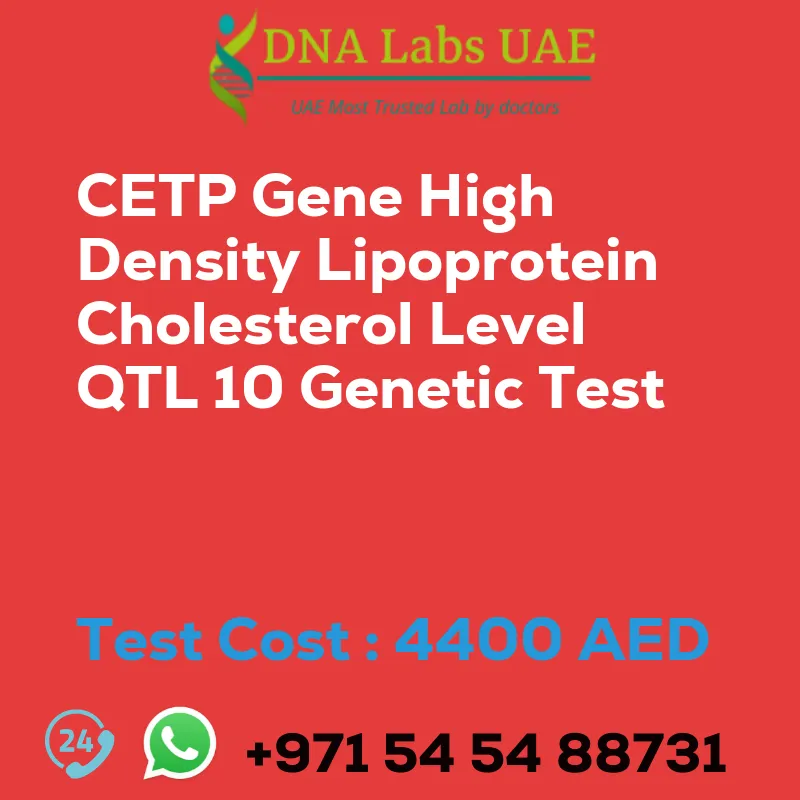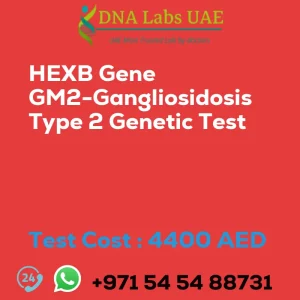CETP Gene High Density Lipoprotein Cholesterol Level QTL 10 Genetic Test
Test Name: CETP Gene High Density Lipoprotein Cholesterol Level QTL 10 Genetic Test
Components: CETP gene sequencing, QTL 10 region sequencing
Price: 4400.0 AED
Sample Condition: Blood or Extracted DNA or One drop Blood on FTA Card
Report Delivery: 3 to 4 Weeks
Method: NGS Technology
Test Type: Metabolic Disorders
Doctor: General Physician
Test Department: Genetics
Pre Test Information: Clinical History of Patient who is going for CETP Gene High Density Lipoprotein Cholesterol Level QTL 10 NGS Genetic DNA Test. A Genetic Counselling session to draw a pedigree chart of family members affected with High Density Lipoprotein Cholesterol Level QTL 10.
Test Details:
The CETP gene is responsible for encoding the cholesteryl ester transfer protein (CETP), which plays a crucial role in lipid metabolism. High-density lipoprotein (HDL) cholesterol is often referred to as “good” cholesterol as it helps remove low-density lipoprotein (LDL) cholesterol from the bloodstream. A QTL (quantitative trait locus) is a specific region of the genome that is associated with a particular phenotype or trait. In this case, QTL 10 refers to a region on chromosome 10 that is associated with the HDL cholesterol levels.
NGS (Next-Generation Sequencing) is a high-throughput DNA sequencing technology that allows for the rapid and cost-effective analysis of large amounts of genetic data. In the context of a genetic test for the CETP gene and HDL cholesterol levels, NGS would involve sequencing the relevant region of the genome to identify any genetic variants or mutations that may be associated with changes in HDL cholesterol levels.
Therefore, a CETP Gene High-density lipoprotein cholesterol level QTL 10 NGS genetic test would involve sequencing the CETP gene and the QTL 10 region to identify any genetic variants that may be associated with variations in HDL cholesterol levels. This test can provide valuable information about an individual’s genetic predisposition to HDL cholesterol levels and help in assessing their risk for cardiovascular diseases.
| Test Name | CETP Gene High density lipoprotein cholesterol level QTL 10 Genetic Test |
|---|---|
| Components | |
| Price | 4400.0 AED |
| Sample Condition | Blood or Extracted DNA or One drop Blood on FTA Card |
| Report Delivery | 3 to 4 Weeks |
| Method | NGS Technology |
| Test type | Metabolic Disorders |
| Doctor | General Physician |
| Test Department: | Genetics |
| Pre Test Information | Clinical History of Patient who is going for CETP Gene High density lipoprotein cholesterol level QTL 10 NGS Genetic DNA Test A Genetic Counselling session to draw a pedigree chart of family members affected with High density lipoprotein cholesterol level QTL 10 |
| Test Details |
The CETP gene is responsible for encoding the cholesteryl ester transfer protein (CETP), which plays a crucial role in lipid metabolism. High-density lipoprotein (HDL) cholesterol is often referred to as “good” cholesterol as it helps remove low-density lipoprotein (LDL) cholesterol from the bloodstream. A QTL (quantitative trait locus) is a specific region of the genome that is associated with a particular phenotype or trait. In this case, QTL 10 refers to a region on chromosome 10 that is associated with the HDL cholesterol levels. NGS (Next-Generation Sequencing) is a high-throughput DNA sequencing technology that allows for the rapid and cost-effective analysis of large amounts of genetic data. In the context of a genetic test for the CETP gene and HDL cholesterol levels, NGS would involve sequencing the relevant region of the genome to identify any genetic variants or mutations that may be associated with changes in HDL cholesterol levels. Therefore, a CETP Gene High-density lipoprotein cholesterol level QTL 10 NGS genetic test would involve sequencing the CETP gene and the QTL 10 region to identify any genetic variants that may be associated with variations in HDL cholesterol levels. This test can provide valuable information about an individual’s genetic predisposition to HDL cholesterol levels and help in assessing their risk for cardiovascular diseases. |








